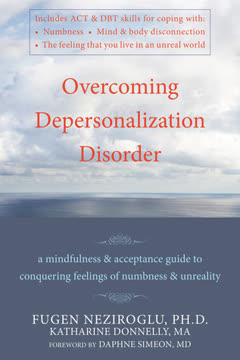Key Takeaways
1. Depersonalization: A Common Yet Misunderstood Experience
Most people in your life don’t understand what depersonalization feels like or how much it makes you suffer.
Defining Depersonalization. Depersonalization involves feeling detached from one's mental processes or body, as if observing oneself from the outside. Derealization, a related phenomenon, alters the perception of the external world, making it seem strange or unreal. While fleeting experiences of depersonalization are common, chronic depersonalization disorder (DPD) affects an estimated 2% of the population, causing significant distress and impairment.
Symptoms and Diagnosis. Symptoms range from emotional numbness and a sense of unreality to perceptual distortions and cognitive difficulties. Individuals may feel like robots, disconnected from their own actions and emotions, or as if they are living in a dream. Diagnosis requires persistent or recurrent feelings of detachment, intact reality testing (awareness that the experiences are unusual), and significant impairment in functioning, and it is best confirmed by a mental health professional.
Impact on Daily Life. DPD can disrupt concentration, goal achievement, and social interactions. Sufferers often feel disorganized, confused, and isolated, struggling to explain their experiences to others. This can lead to avoidance behaviors, such as avoiding social situations or mentally strenuous tasks, further limiting their quality of life.
2. Self-Focus: The Paradoxical Intensifier of DPD
Self-focus means constant monitoring of internal sensations that heighten your sensitivity to the feeling of depersonalization.
The Problem with Problem-Solving. Human nature drives us to solve problems, but when it comes to DPD, trying to "think your way out" often backfires. Constant self-monitoring and obsessive focus on internal sensations can actually worsen the feelings of depersonalization, creating a vicious cycle of distress. This is because the more you focus on the symptoms, the more real and overwhelming they become.
Obsession and Rumination. Two key culprits in this process are obsession and rumination. Obsessions are intrusive, forceful thoughts that get stuck in the mind, while ruminations involve dwelling on unresolved issues and worries. Both heighten self-focus and exacerbate feelings of depersonalization, leading to increased anxiety, frustration, and hopelessness.
Acceptance as an Alternative. The alternative to this relentless cycle is acceptance: being willing to experience the feeling, stopping the war with negative thinking, and giving your discomfort some room to be there as you work toward living the life you want. This doesn't mean liking the feeling, but rather refusing to let it dictate your actions and limit your experiences.
3. Unraveling the Roots: Trauma, Culture, and Biology
We find that many people with DPD have experienced some form of trauma in the past.
The Role of Trauma. Many individuals with DPD have a history of trauma, including child abuse, rape, or exposure to violence. Dissociation, including depersonalization, can serve as a defense mechanism, separating the pain from conscious awareness. However, this adaptive response can become chronic, interfering with normal psychological development.
Cultural and Social Factors. Cultural norms that discourage emotional expression can also contribute to DPD. In some societies, stoicism and suppression of emotions are valued, leading individuals to dissociate as a way to maintain socially acceptable behavior. Disruption of cultural identity, such as through emigration or exposure to sociohistorical events, can also be a source of trauma.
Neurobiological Underpinnings. Research suggests that DPD involves abnormalities in brain function and neurochemistry. Studies have identified altered activity in brain regions involved in emotional processing, sensory integration, and autonomic regulation. Neurotransmitters like NMDA, serotonin, and opioids may also play a role in the development and maintenance of DPD.
4. DPD and Its Companions: Overlapping Conditions
Depersonalization is a symptom that’s associated with many disorders.
DPD as Primary vs. Secondary. It's crucial to distinguish between primary (chronic) DPD and secondary (episodic) depersonalization. Episodic depersonalization is a temporary response to extreme stress or trauma, while chronic DPD is a persistent condition that significantly impairs functioning. DPD often co-occurs with other psychological disorders, making accurate diagnosis challenging.
Commonly Overlapping Conditions:
- Panic Disorder: DPD can occur during or after panic attacks, and both conditions share symptoms like anxiety and a sense of losing control.
- PTSD: Trauma survivors often experience dissociation, including depersonalization, as a way to cope with distressing memories and emotions.
- OCD: Obsessive thinking and compulsive behaviors can be linked to DPD, particularly philosophical obsessions and health anxiety.
- BPD: Borderline personality disorder shares features with DPD, such as emotional dysregulation, feelings of emptiness, and a disturbed self-image.
- Affective Disorders: DPD is frequently misdiagnosed as depression, as both conditions involve loss of interest and difficulty concentrating.
The Importance of Accurate Diagnosis. Because of the overlap with other disorders, it's essential to seek a comprehensive evaluation from a mental health professional experienced in treating dissociative conditions. Accurate diagnosis is the first step toward effective treatment.
5. ACT: Embracing Discomfort for a Richer Life
The alternative is being willing to experience the feeling, to stop the war with negative thinking, and to give your discomfort some room to be there as you work toward living the life you want.
Shifting the Focus. Acceptance and Commitment Therapy (ACT) offers a different approach to managing DPD. Instead of trying to eliminate unpleasant thoughts and feelings, ACT focuses on accepting them and committing to valued actions, even in the presence of discomfort. The goal is to increase psychological flexibility, allowing individuals to live a meaningful life despite their symptoms.
Core Processes of Psychological Inflexibility:
- Cognitive Fusion: Buying into thoughts as absolute truths.
- Self as Content: Identifying with thoughts, feelings, and labels.
- Rumination and Worry: Getting stuck in past or future thinking.
- Experiential Avoidance: Trying to avoid unpleasant internal experiences.
- Lack of Values Clarity: Not knowing what's truly important.
- Narrow Behavioral Repertoire: Limiting actions due to discomfort.
Cultivating Psychological Flexibility. ACT aims to counter these processes by fostering cognitive defusion (seeing thoughts as just thoughts), a transcendent sense of self (recognizing a constant observer), mindfulness (being present in the moment), acceptance and willingness (embracing discomfort), values clarification (identifying chosen life directions), and committed action (behaving in accordance with values).
6. DBT: Finding Balance in a World of Extremes
Dialectics also recognize that two opposite ideas can be simultaneously correct.
The Dialectical Approach. Dialectical Behavior Therapy (DBT) emphasizes finding balance between seemingly contradictory ideas. It recognizes that both logic and emotion are essential for well-being and that acceptance and change are not mutually exclusive. DBT aims to help individuals regulate their emotions, tolerate distress, and improve interpersonal effectiveness.
Key Dialectics in DBT:
- Rational vs. Emotional Mind: Finding a synthesis between logical thinking and emotional impulses.
- Acceptance vs. Change: Balancing acceptance of current reality with efforts to improve it.
- The Misery of DPD vs. Feeling Numb: Acknowledging both the pain of DPD and the emotional numbness it can cause.
Core Skills of DBT:
- Mindfulness: Paying attention to the present moment without judgment.
- Distress Tolerance: Developing skills to cope with intense emotional pain.
- Emotion Regulation: Learning to manage and change emotional responses.
- Interpersonal Effectiveness: Improving communication and relationship skills.
Applying DBT to DPD. DBT skills can be particularly helpful for individuals with DPD who struggle with emotional dysregulation, interpersonal difficulties, and a tendency to avoid distressing situations. By fostering mindfulness, distress tolerance, and emotion regulation, DBT can empower individuals to live more fulfilling lives despite their symptoms.
7. Behavioral Strategies: Action as a Path to Change
Your behavior is the only thing you can show to the outside world, and it’s the only thing you truly have any control over.
The Power of Behavior. While thoughts and feelings can be difficult to control directly, behavior is a tangible action that can be influenced. Behavioral therapy (BT) focuses on changing behavior to improve psychological well-being. This often involves increasing contact with feared situations and preventing avoidance responses.
Exposure and Response Prevention (ERP). ERP is a key technique in BT. It involves exposing oneself to situations that trigger anxiety or depersonalization and preventing the usual avoidance behaviors. This helps individuals learn that the feared consequences don't always occur and that they can cope with the discomfort.
Types of Exposure:
- Traumatic Experiences: Recounting and re-experiencing traumatic events in detail.
- Disastrous Consequences: Imagining and elaborating on worst-case scenarios.
- Interoceptive Cues: Intentionally inducing physical sensations associated with anxiety.
- Extreme Emotions: Engaging in activities that evoke intense feelings.
- Feared Situations: Gradually confronting situations that trigger depersonalization.
Behavioral Activation. In addition to exposure, behavioral activation involves re-engaging in enjoyable or reinforcing activities. This helps combat the loss of interest and motivation that often accompanies DPD, leading to a richer and more fulfilling life.
8. Beyond the Core: Exploring Alternative Treatments
No pharmacological treatment has been found to work indefinitely for depersonalization.
Cognitive Behavioral Therapy (CBT). While this book emphasizes acceptance-based approaches, traditional CBT can also be helpful. CBT focuses on identifying and changing negative or irrational thinking patterns that contribute to DPD. This involves examining the evidence for and against these thoughts and generating more balanced and realistic interpretations.
Wellness Strategies. Prioritizing self-care, health, diet, routine, exercise, sleep, and hygiene can significantly enhance psychological well-being. Incorporating these elements into a daily routine can provide a foundation for managing DPD symptoms.
Psychopharmacological Options. While no medication is a definitive cure for DPD, certain drugs can help manage specific symptoms. SSRIs may alleviate depression, Anafranil can target obsessive thinking, benzodiazepines can reduce anxiety, and Naltrexone may address dissociative symptoms.
Experimental Treatments. Transcranial magnetic stimulation (TMS) and cingulotomy are experimental treatments that have shown some promise for severe, treatment-resistant DPD. However, these options are invasive and carry potential risks, so they should be considered only as a last resort.
Last updated:
FAQ
1. What is "Overcoming Depersonalization Disorder" by Fugen Neziroglu about?
- Comprehensive self-help guide: The book provides a detailed, user-friendly manual for understanding and managing depersonalization disorder (DPD), a condition characterized by feelings of numbness, unreality, and detachment from oneself or the environment.
- Focus on acceptance and mindfulness: It introduces scientifically grounded approaches, especially Acceptance and Commitment Therapy (ACT) and Dialectical Behavior Therapy (DBT), tailored to help readers accept and cope with their symptoms.
- Practical exercises and examples: The book includes real-life vignettes, exercises, worksheets, and summaries to help readers apply the concepts to their own lives.
- Resource for sufferers and clinicians: It is written for both individuals experiencing DPD and mental health professionals seeking effective treatment strategies.
2. Why should I read "Overcoming Depersonalization Disorder" by Fugen Neziroglu?
- Addresses a misunderstood disorder: DPD is often underdiagnosed and misdiagnosed; this book fills a gap by offering clear explanations and practical help.
- Evidence-based strategies: The book draws on current research and proven therapeutic methods, making it a reliable resource for recovery.
- Empowering and hopeful: It emphasizes that while there is no quick cure, DPD is treatable, and readers can regain control over their lives.
- Support for families and professionals: The book also helps loved ones and clinicians understand the disorder, improving support networks and treatment outcomes.
3. What are the key takeaways from "Overcoming Depersonalization Disorder" by Fugen Neziroglu?
- Acceptance over avoidance: Trying to "think your way out" of DPD or avoid discomfort often makes symptoms worse; acceptance and willingness to experience discomfort are more effective.
- Mindfulness and present-moment focus: Staying grounded in the present and practicing mindfulness can reduce the impact of depersonalization symptoms.
- Behavioral activation is crucial: Engaging in valued life activities, even when feeling numb or detached, helps counteract the disorder’s isolating effects.
- DPD is treatable: While there is no instant cure, a combination of acceptance, behavioral strategies, and sometimes medication can significantly improve quality of life.
4. What is depersonalization disorder (DPD) as defined in "Overcoming Depersonalization Disorder"?
- Core symptoms: DPD involves persistent or recurrent feelings of being detached from one’s mental processes or body, as if observing oneself from outside.
- Distress and impairment: These experiences cause significant distress and interfere with social, work, or other important areas of functioning.
- Reality testing remains intact: Unlike psychosis, individuals with DPD are aware that their experiences are unusual and not based in external reality.
- Not due to other causes: DPD is diagnosed only when symptoms are not better explained by another disorder, substance use, or medical condition.
5. What are the main causes and triggers of depersonalization disorder according to Fugen Neziroglu?
- Trauma and stress: Both acute and prolonged trauma, such as abuse, neglect, or major life stressors, are common triggers for DPD.
- Drug use: Substances like marijuana, ketamine, and other hallucinogens can precipitate depersonalization episodes, sometimes leading to chronic symptoms.
- Neurobiological factors: Research suggests abnormalities in brain chemistry and function, particularly in areas related to emotion and sensory integration, may contribute.
- Cultural and family factors: Cultural attitudes toward emotion and dysfunctional family dynamics can also play a role in the development of DPD.
6. How does "Overcoming Depersonalization Disorder" explain the relationship between DPD and other psychological conditions?
- Overlap with other disorders: DPD often co-occurs with anxiety disorders (especially panic disorder), depression, obsessive-compulsive disorder (OCD), and borderline personality disorder (BPD).
- Symptom similarities: Many symptoms of DPD, such as emotional numbness and detachment, can mimic or be mistaken for symptoms of depression or anxiety.
- Adaptive vs. maladaptive: The book distinguishes between episodic (adaptive, short-term) and chronic (maladaptive, long-term) depersonalization.
- Importance of accurate diagnosis: Understanding these overlaps is crucial for effective treatment and avoiding misdiagnosis.
7. What is Acceptance and Commitment Therapy (ACT) and how is it applied to DPD in this book?
- Core principles: ACT focuses on increasing psychological flexibility by accepting unpleasant thoughts and feelings rather than fighting them, and committing to actions aligned with personal values.
- Six dysfunctional processes: The book identifies cognitive fusion, self-identification with thoughts, rumination, experiential avoidance, lack of value clarity, and narrow behavioral repertoire as key issues in DPD.
- Practical exercises: Readers are guided through mindfulness, cognitive defusion, values clarification, and committed action exercises tailored to DPD.
- Goal of ACT: The aim is not to eliminate symptoms, but to help individuals live a meaningful life despite them.
8. How does Dialectical Behavior Therapy (DBT) help with depersonalization disorder according to Fugen Neziroglu?
- Balancing acceptance and change: DBT teaches that both acceptance of distress and efforts to change unhelpful behaviors are necessary for recovery.
- Key skills taught: Mindfulness, distress tolerance, emotion regulation, and interpersonal effectiveness are emphasized as tools for managing DPD symptoms.
- Managing emotional dysregulation: DBT helps individuals recognize and respond to intense emotions without resorting to avoidance or self-destructive behaviors.
- Assertive communication: The book provides guidance on improving relationships and reducing isolation through effective, assertive communication.
9. What behavioral strategies does "Overcoming Depersonalization Disorder" recommend for managing DPD?
- Exposure and response prevention (ERP): Gradually facing situations, sensations, or emotions that trigger depersonalization, rather than avoiding them, helps reduce their power.
- Behavioral activation: Re-engaging in enjoyable or meaningful activities, even when feeling numb, can help restore a sense of purpose and connection.
- Interoceptive exposure: Deliberately experiencing uncomfortable bodily sensations to reduce fear and avoidance of these sensations.
- Hierarchy of feared situations: The book suggests creating and working through a personalized list of avoided situations to systematically build tolerance.
10. What other treatment options for DPD are discussed in "Overcoming Depersonalization Disorder"?
- Cognitive Behavioral Therapy (CBT): Traditional CBT techniques, such as identifying and challenging distorted thoughts, can be helpful for some individuals.
- Pharmacological treatments: Medications like SSRIs, tricyclic antidepressants, benzodiazepines, and opioid antagonists may provide symptom relief, though no drug is universally effective.
- Experimental treatments: Transcranial magnetic stimulation (TMS) and cingulotomy are mentioned as experimental options for severe, treatment-resistant cases.
- Wellness and self-care: The book emphasizes the importance of routine, sleep, diet, exercise, and overall wellness as supportive measures.
11. What are the most important practical exercises and advice in "Overcoming Depersonalization Disorder"?
- Mindfulness and grounding: Regular mindfulness exercises help anchor attention in the present and reduce rumination.
- Values clarification: Identifying and acting on personal values provides direction and motivation, even when symptoms persist.
- Assertive communication: Practicing clear, non-judgmental communication with loved ones can reduce isolation and misunderstanding.
- Behavioral experiments: Systematic exposure to feared situations, sensations, and emotions builds resilience and reduces avoidance.
12. What are the best quotes from "Overcoming Depersonalization Disorder" by Fugen Neziroglu and what do they mean?
- “Beating depersonalization means refusing to let it push you around and dictate how you’ll live your life.” This highlights the book’s core message of empowerment and taking back control through acceptance and action.
- “There’s no cure for depersonalization disorder, and searching for a way out of it may even do more harm than good.” The authors caution against the trap of endless problem-solving and advocate for acceptance as a healthier approach.
- “Nothing worth pursuing is painless, and that includes using the strategies in this book to cope with depersonalization.” Recovery is framed as a challenging but meaningful process, requiring courage and persistence.
- “Acceptance can help you live the life you choose. Your suffering is intense, and it’s hard to imagine being willing to experience it. But meanwhile, waiting for things to get better and trying to force things to get better have still left you in pain and waiting.” This quote encapsulates the book’s philosophy: acceptance and committed action are the path forward, not waiting for symptoms to disappear.
Review Summary
Overcoming Depersonalization Disorder receives mixed reviews, with an average rating of 3.83/5. Some readers find it helpful and informative, praising its strategies and educational content. Others criticize its approach, arguing that it lacks scientific support and may be dismissive of patients' experiences. The book's coverage of DBT and ACT as treatments is controversial, with some readers questioning its efficacy for depersonalization disorder. While some appreciate the practical exercises and insights provided, others feel the book oversimplifies the condition and doesn't offer enough detailed guidance.
Download PDF
Download EPUB
.epub digital book format is ideal for reading ebooks on phones, tablets, and e-readers.







